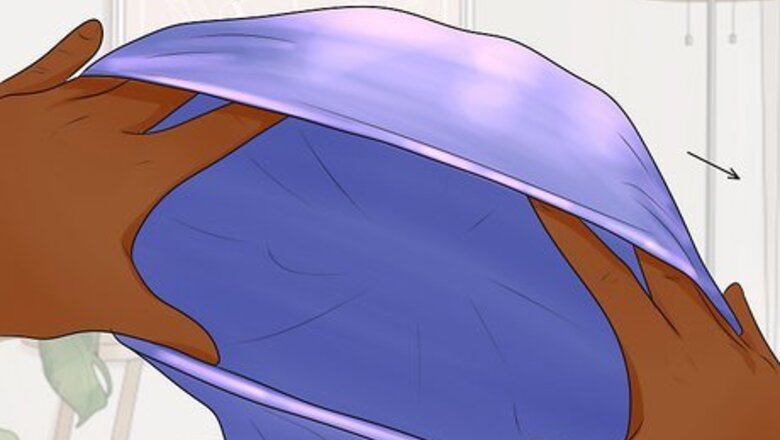
views
- Keep all your hair in your bonnet and pile it at the crown of your head so it's less likely to slip out. Tuck your stray and wispy hairs in, too, to prevent any breakage.
- Invest in a high-quality bonnet that's the right size for your head and can stretch to fit all your hair. That way, you'll avoid your hair getting snagged or tangled.
- To keep your bonnet extra secure, slip in bobby pins or close hair clips around the perimeter of it. Alternatively, tie it up with any ribbons it comes with or a silk scarf.
- Wear a bonnet regularly to enjoy all its benefits, like keeping your hair moisturized or maintaining your hairstyle. Plus, you'll save yourself a lot of pricey trips to the salon.
How to Put on a Bonnet
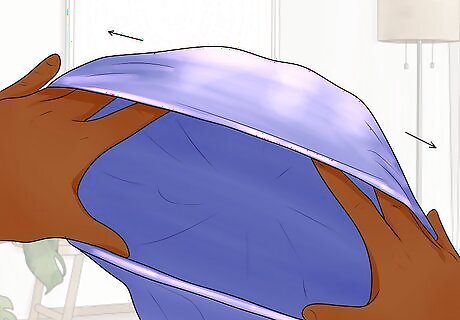
Hold your bonnet open. Place your hands inside your bonnet—make sure each of your hands is on either side of your bonnet. Bend your hands backward at the wrists to tug at your bonnet’s elastic band and stretch out your bonnet. Expand your bonnet as much as you can.
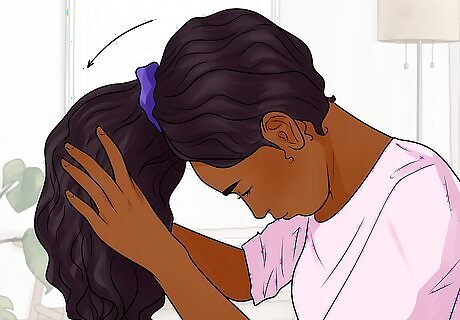
Flip your hair upside down. Bend over and flip your hair so all of it falls over your face. Lean forward so all of your hair pools inside your opened up bonnet. If you have very long hair—whether it’s curls, straight tresses, locs—fold it in on itself “accordion style” so it all fits in your bonnet. Once most of your hair is inside the bonnet, take your hands out so they're freed up—that way, you can start to adjust and re-position your bonnet.
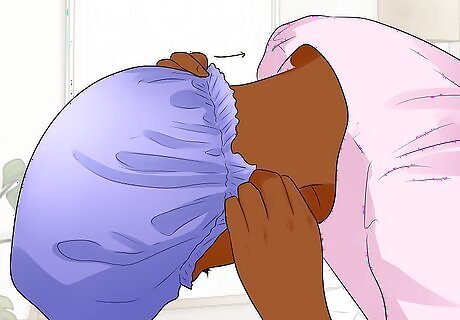
Pull the back of the bonnet over the nape of your neck. To secure your bonnet onto your head, hook the elastic band at the back of your bonnet onto the nape of your neck. Adjust the elastic band so it sits straight on the back of your neck (instead of being bunched up or off-center).
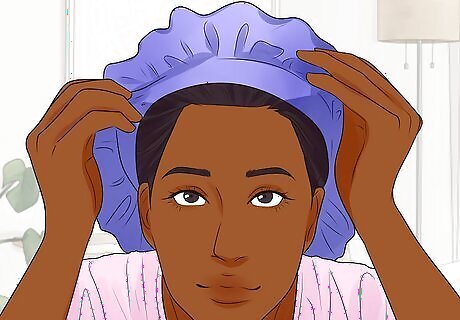
Stretch your bonnet over all your hair. Pull the front of your bonnet to catch all of your lovely hair, whether it’s straight tresses, bouncy curls, gorgeous natural locs, or a luscious afro. Adjust the elastic band at the front of your bonnet so it sits straight on your hairline.
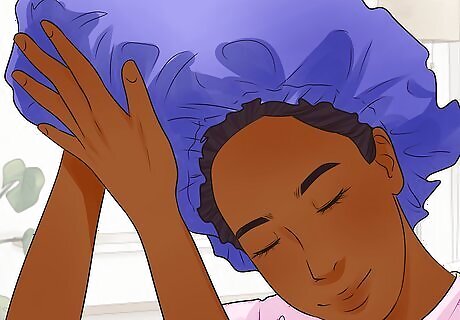
Press the ends of your hair toward your scalp. Hold onto the side of your bonnet and slide your other hand inside of it. Run your fingers through your hair to pile it all up at the crown of your head. Gently pat down your hair so it stays in place. When you gather all your hair up so it’s at the top of your head, it’s less likely to slip out of your bonnet. To secure your hair at the crown of your head, put it in a bun. If you've got curly or coily hair, "pineapple" it by using a scrunchie to gather it up in a loose bun.
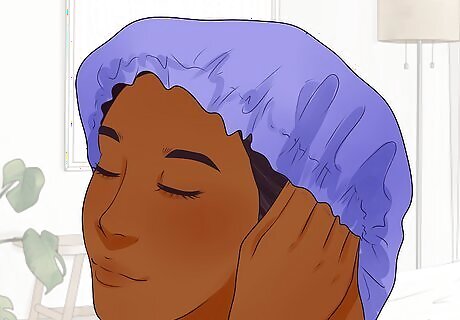
Tuck any stray hairs into your bonnet. If there’s any stray or wispy hairs peeking outside the perimeter of your bonnet, use two fingers to gently slide them back in. To make sure everything stays in place, secure your hair bonnet with bobby pins or hair clips. You’ve now finished up the quick process of putting your bonnet on—stand up, admire your handiwork in the mirror, and look forward to super healthy hair.
Keeping a Bonnet on at Night
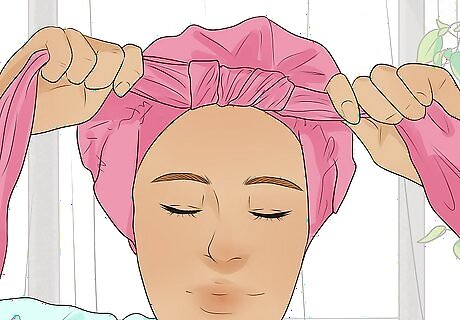
Tie your bonnet a bit tighter if it ties in the front. Some hair bonnets are “tie bonnets”—if you get one of these cute and girly products, it’ll have 2 ribbons that hang down on either side of it. Hold onto both of them, pull them up, and tie them in a bow at the center of your hairline. Be careful not to tie the ribbons too tightly—otherwise, you'll cut off a lot of circulation to your hair. Remember, that blood flow is really important for hair growth.
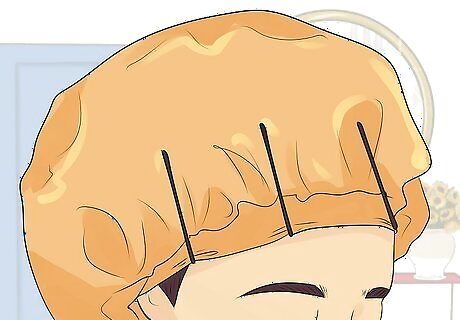
Use bobby pins or hair clips to secure your bonnet. Slip bobby pins or close hair clips around the perimeter of your bonnet. This extra precaution helps make sure your bonnet will stay put.
Wrap a scarf around your bonnet to hold it in place. For a comfy way to keep your bonnet from slipping off, grab a cute silk scarf. Hold onto either end of it and pull up both ends to create a “U” shape. Place your chin in the center of the scarf, then tie the 2 ends into a bow that sits on the crown of your head.
Choosing the Right Bonnet
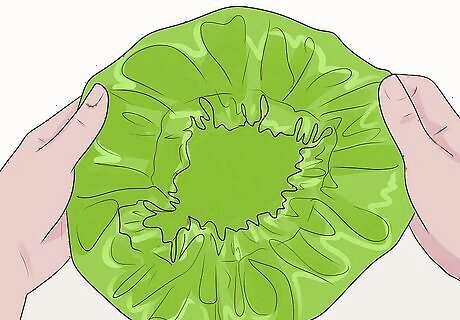
Buy a high-quality silk or satin bonnet. Go for either satin or silk—these sumptuous fabrics prevent friction so your hair doesn’t get snagged or break. Your hair will just glide against these gentle materials. Plus, both silk and satin lock in moisture. Steer clear of bonnets with cotton lining and other drying fabrics that absorb moisture, because dry dehydrated hair is prone to frizz. These materials are too rough for your lovely tresses. To decide if a silk bonnet or satin bonnet is best for you, think about these trade-offs: Silk Pros: Eco-friendly, breathable, helps regulate your body temp while you sleep, keeping the hair hydrated Cons: Pricey, so some companies pass off bonnets as “silk” when they’re not Satin: Pros: Cheap, ultra-smooth, extremely protective of your hair Cons: Only the inner lining of bonnets have satin, so they’re a little less comfy Tip: When you pick out your bonnet, look for any exposed elastic, which is a sign of a poorly sewn band that might pull out your hair.
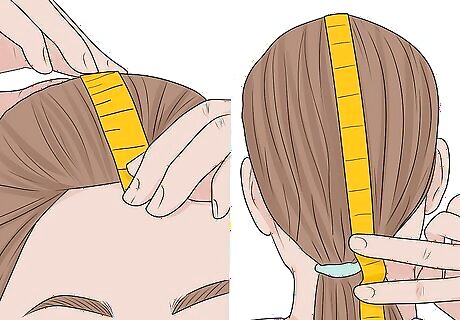
Get a bonnet that’s the right size for your head and hair. Measure your head from your forehead to the nape of your neck. Compare your measurement to the options on a company’s size chart for hair bonnets. When you get the right bonnet for the size of your head, it'll stretch enough to accommodate all your hair. If your measurement is 52 centimetres (20 in), you might read one manufacturer's size chart and see that you'll fit into a "Medium" bonnet, which is 52 centimetres (20 in) relaxed and stretches all the way to 56 centimetres (22 in). If you want your bonnet fit over your ears, wrap the measuring tape around your ears when you take your measurement. If your bonnet's band is tight, it can damage delicate strands and put pressure on your hairline, which cuts off circulation and prevents hair growth. If your bonnet’s band is loose, your bonnet can easily fall off while you sleep, so you won’t enjoy all its benefits.
Invest in an extra large bonnet for very long hair or voluminous afros. When you have hair with a lot of length or volume, go for an extra large bonnet, a specialty type of sleeping cap. For long tresses or dreadlocks, look for an extra large bonnet that drops down to your back. For an afro, go for an extra large—sometimes called “jumbo”—bonnet that’s really wide and circular. Whether you need an extra large bonnet that drops down for long hair or one that stretches to accommodate a wide afro, look for the manufacturer’s measurement, which is given as a diameter. For example, if your hair is 17 inches (43 cm) long, get an extra large bonnet that has a diameter of 17 inches (43 cm). For an afro that’s 14 inches (36 cm) wide, buy an extra large bonnet that’s 14 inches (36 cm) in diameter.
Benefits of Wearing a Bonnet
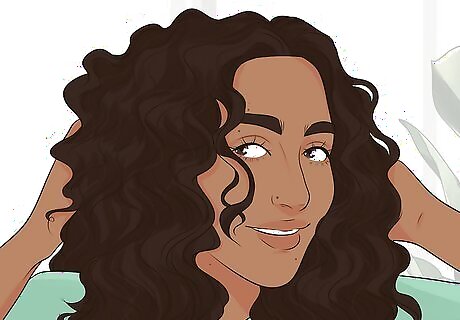
A bonnet keeps your hair healthy and saves you money. A bonnet protects your hair so it doesn't get tangled or tousled while you toss and turn. It'll also make sure your hair products stay on your tresses and off your pillow. Since your bonnet will keep your hair strong, nourished, and shiny, you won't have to go to your stylist so often. Overall, a bonnet can: Prevent hair breakage and split ends Lock in moisture for your hair Help your hair absorb products, like an overnight leave-in conditioner Maintain your hairstyle, like preserving curls or an afro Reduce frizz Protect your skin from natural hair oils that clog pores Save money by skipping pricey salon visits




















Comments
0 comment